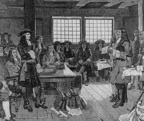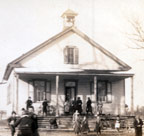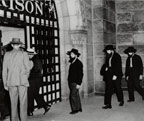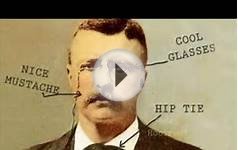 Library of Congress
Library of Congress
William Penn confers with colonists
1682
William Penn arrives in America on the ship Welcome and founds Pennsylvania. A Quaker, Penn promotes religious freedom in the colony that he creates as his "holy experiment." Pennsylvania will become a refuge for both Native Americans and people of various religious denominations who are being persecuted elsewhere.
1683
Thirteen German Mennonite families arrive in Pennsylvania seeking religious freedom. They found Germantown six miles north of Philadelphia.
1737
The Charming Nancy sets sail for North America from the Netherlands with 21 Amish families. Over the next three decades, about 100 families will make the crossing.
 1749
1749
Jacob Hertzler, the first well-known Amish bishop in North America settles in Northkill Creek, in Berks County north of Philadelphia, Pennsylvania.
1807
Over the next 50 years, 3, 000 Amish will immigrate to North America from Europe.
1809
Amish begin settling in eastern Ohio, farming side by side with the Native Americans already there. Twenty five years later, this community will consist of approximately 250 Amish families.
 Landis Valley Museum
Landis Valley Museum
A one-room schoolhouse in Pennsylvania
1844
Communities in Pennsylvania and around the country establish one-room public schools, which typically run through the eighth grade with one teacher for all students. In many areas, Amish and English children attend the same schools and leave around age 14 to work on their family farms.
Amid Amish settlements, various churches debate over dress code, separation from society, and use of technology such as photography. The intensifying debates culminate in the first all-church Amish ministers' conference in Wayne County, Ohio (Diener-Versammlung), which will occur almost annually until 1878.
 1865
1865
The more conservative Amish depart this year's Diener-Versammlung dissatisfied and trigger a gradual but major division within Amish communities in North America. For the first time, the more conservative flank becomes known as "Old Order" Amish because they cling to the Old Ordnung. The more progressive Amish become Amish-Mennonites, and slowly over several decades become assimilated into Mennonite churches.
1865-1866
The Egly Amish form under Bishop Henry Egly from Adams County, Indiana. Egly mixes evangelical sentiments with the beliefs of the Amish, promoting personal conversion, and takes a more personal authority over the congregation.
1872-1878
The Stuckey Amish form under bishop Joseph Stuckey from McLean County, Illinois. They allow excommunicated members from other communities to join, are more relaxed in their restrictions, and believe God will save all of humanity regardless of religious affiliation.








